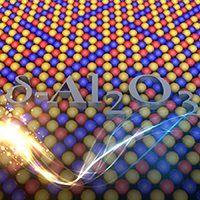Weaving a Catalyst
Popular aluminum oxide created by interlacing different crystal forms
(November 2014)

Scientists obtained an atomically resolved view of delta alumina. Using experiments and computational approaches, the team showed that the oxide is two crystal forms woven together. Enlarge Image.
Results: The exhaust system in your car and the plastic cup holding your drink, along with countless other products, rely upon reactions driven by catalysts supported on aluminum oxides. Characterizing these aluminum oxides or alumina has been challenging. For the first time, scientists at Pacific Northwest National Laboratory (PNNL) and FEI Company obtained an atomically resolved view of the alumina form known as delta alumina. Using experiments and computational approaches, the team showed that the oxide is two crystal forms or variants woven together.
"They interweave at the atomic level," said Dr. Libor Kovarik, PNNL scientist and lead author on the study. "The result is not a simple structure."
Why It Matters: Less waste. More product. Less energy. More speed. These items are on nearly every manufacturers' wish list. One way to check the items off is to rejigger the structure of the catalyst's support to make the catalyst faster or more efficient. Such changes require a detailed understanding of the structure. Conventional approaches have not always delivered conclusive results. By taking a different approach to synthesis and chemical imaging, the team obtained detailed information that could, one day, help industrial processes be faster and more efficient.
"Using chemical imaging techniques in a clever way, we can solve old, important problems," said Dr. Janos Szanyi, who has extensively studied alumina supports to create improved catalysts.
Methods: In studying delta alumina, the first challenge in characterizing the material is the material itself. Each crystal is only a few nanometers long (the same width as 10 hydrogen atoms). The team designed a new synthesis approach that resulted in larger, well-defined crystals, stretching 50 nanometers across. With these larger crystals, the team could use a host of imaging tools.
They began with a high-angle annular dark field electron microscope at a national scientific user facility in Washington State, known as EMSL. Sponsored by the U.S. Department of Energy's (DOE's) Office of Biological and Environmental Research, the facility contains a host of instruments, available for free when certain conditions are met. "Without the microscopy in EMSL, this work would not have been done," said Kovarik. "Their new microscopes are very powerful and can resolve the crystal structure at the atomic scale."
The crystal structures of these transitional aluminas were also studied by X-ray diffraction, also available at EMSL. In addition, the team used EMSL's supercomputer (Cascade) to derive energetic stability using density functional theory calculations to get at the heart of the material's structure.
The result was a clear picture of where the aluminum atoms were located in the oxygen framework. Specifically, they uncovered how delta alumina contains interwoven domains with different crystal arrangements or symmetries but with similar atomic bonding. This knowledge provides a foundation for designing better catalysts, which sit on the surface of transition aluminas.
What's Next? The researchers are continuing to characterize the structure and behavior of delta alumina and its related polymorph, gamma alumina. "The materials present a lot of questions," said Kovarik. "We are working to understand them, particularly the aluminum bonding on the catalysts surface."
Acknowledgments
Sponsors: L.K., M.B., and A.G. were supported by the Chemical Imaging Initiative at PNNL as part of the Laboratory Directed Research and Development Program at PNNL. C.H.F.P., J.S., and J.H.K. were supported by DOE, Office of Science, Office of Basic Energy Sciences, Chemical Sciences, Geosciences, and Biosciences Division.
Research Area: Chemical Sciences
User Facility: EMSL, a national scientific user facility sponsored by the DOE's Office of Biological and Environmental Research and located at PNNL
Research Team: Libor Kovarik, Mark Bowden, Janos Szanyi, and Charles H. F. Peden, PNNL; Arda Genc, FEI Company; Ja Hun Kwak, PNNL and now with the School of Nanobiotechnology & Chemical Engineering, UNIST, Korea
Reference: Kovarik L, M Bowden, A Genc, J Szanyi, CHF Peden, and JH Kwak. 2014. "Structure of δ-Alumina: Toward the Atomic Level Understanding of Transition Alumina Phases." The Journal of Physical Chemistry C 118(31):18051-18058. DOI: 10.1021/jp500051j
